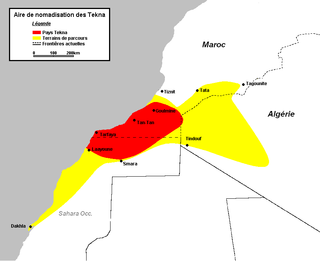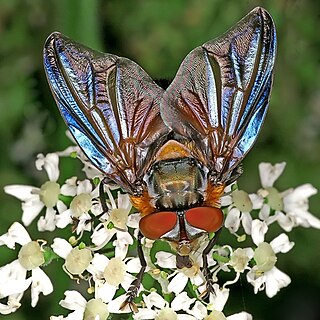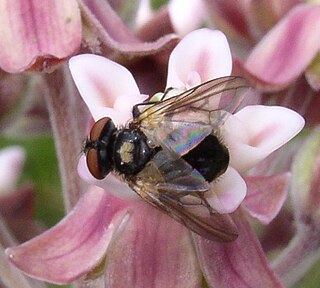
The Ababda are an Arab or Beja tribe in eastern Egypt and Sudan. Historically, most were Bedouins living in the area between the Nile and the Red Sea, with some settling along the trade route linking Korosko with Abu Hamad. Numerous traveler accounts from the nineteenth century report that some Ababda at that time still spoke Beja or a language of their own, hence many secondary sources consider the Ababda to be a Beja subtribe. Most Ababda now speak Arabic and identify as an Arab tribe from the Hijaz. The Ababda have a total population of over 250,000 people.
Zenaga is a Berber language on the verge of extinction currently spoken in Mauritania and northern Senegal by a few hundred people. Zenaga Berber is spoken as a mother tongue from the town of Mederdra in southwestern Mauritania to the Atlantic coast and in northern Senegal. The language is recognized by the Mauritanian government.

The Tekna is a semi-nomadic Sahrawi tribal confederation of mixed Arab and Lamta Sanhaja Berber origins. Its constituents today inhabit southern Morocco, northern Western Sahara and western Algeria, but traditionally with wider migration routes.
The Salyes or Salluvii were an ancient Celto-Ligurian people dwelling between the Durance river and the Greek colony of Massalia during the Iron Age. Although earlier writers called them 'Ligurian', Strabo used the denomination 'Celto-ligurian' in the early 1st century AD. A Celtic influence is noticeable in their religion, which centred on the cult of the tête coupée, as well as in the names of their towns and leaders. During the 2nd century BC, the Salyes were most likely at the head of a political and military confederation that united both Gallic and Ligurian tribes.

Planorbidae, common name the ramshorn snails or ram's horn snails, is a family of air-breathing freshwater snails, aquatic pulmonate gastropod molluscs. Unlike most molluscs, the blood of ram's horn snails contains iron-based hemoglobin instead of copper-based hemocyanin. As a result, planorbids are able to breathe oxygen more efficiently than other molluscs. The presence of hemoglobin gives the body a reddish colour. This is especially apparent in albino animals.
The Banu Ifran or Ifranids, were a Zenata Berber tribe prominent in the history of pre-Islamic and early Islamic North Africa. In the 8th century, they established a kingdom in the central Maghreb, with Tlemcen as its capital.

The Eburovīcēs or Aulercī Eburovīcēs were a Gallic tribe dwelling in the modern Eure department during the Iron Age and the Roman period. They were part of the Aulerci.
The Dassaretii were an Illyrian people that lived in the inlands of southern Illyria, between present-day south-eastern Albania and south-western North Macedonia. Their territory included the entire region between the rivers Asamus and Eordaicus, the plateau of Korça locked by the fortress of Pelion and, towards the north it extended to Lake Lychnidus up to the Black Drin. They were directly in contact with the regions of Orestis and Lynkestis of Upper Macedonia. Their chief city was Lychnidos, located on the edge of the lake of the same name. One of the most important settlements in their territory was established at Selcë e Poshtme near the western shore of Lake Lychnidus, where the Illyrian Royal Tombs were built.

The Labeatae, Labeatai or Labeates were an Illyrian people that lived on the Adriatic coast of southern Illyria, between modern Albania and Montenegro, around Lake Scodra.
Atintanes or Atintanians was an ancient tribe that dwelled in the borderlands between Epirus and Illyria, in an inland region which was called Atintania. They have been described as either an Epirote tribe that belonged to the northwestern Greek group, or as an Illyrian tribe. They were occasionally subordinate to the Molossians.
Sesarethus was an ancient city in southern Illyria. Stephanus of Byzantium from the 6th century AD reports, citing Hecataeus, that Sesarethos was a Taulantian city, and that Sesarethioi was its ethnicon. The city and the tribal name Sessarethes have been related by modern scholars to the Illyrian tribe of Dassaretii. The variant Sesarethii is also mentioned by Strabo as an alternative name of the Enchelei.
The Segobrigii or Segobriges were a Celto-Ligurian people dwelling in the hinterland of the Greek colony of Massalia during the Iron Age.
The Enchelei were an ancient people that lived around the River Drin and the region of Lake Shkodra and Lake Ohrid, in modern-day Albania, Montenegro, and North Macedonia. They are one of the oldest known peoples of the eastern shore of the Adriatic Sea. In ancient sources they sometimes appear as an ethnic group distinct from the Illyrians, but they are mostly mentioned as one of the Illyrian tribes. They held a central position in the earlier phase of Illyrian history. In ancient Greek literature they are linked with the end of the mythical narrative of Cadmus and Harmonia, a tradition deeply rooted among the Illyrian peoples.

Phasiinae is a subfamily of flies in the family Tachinidae. Except for the small tribe Strongygastrini members of this subfamily attack only Heteroptera.

Phasiini is a tribe of flies in the family Tachinidae. As a result of phylogenetic research, most members of this tribe were transferred to other tribes in the subfamily, leaving only the two genera Elomya and Phasia.

The Raḥmâniyya is an Algerian Sufi order founded by Kabyle religious scholar Muḥammad ibn ʿAbd al-Raḥman al-Azhari Bu Qabrayn in the 1770s. It was initially a branch of the Khalwatîya established in Kabylia region. However, its membership grew unwaveringly elsewhere in Algeria and in North Africa.

The Sotiates were a Gallic-Aquitani tribe dwelling in the region surrounding the modern town of Sos (Lot-et-Garonne) during the Iron Age and the Roman period.

The Chaouia is a historical and ethno-geographical region of Morocco. It is bounded by the Oum er-Rbi' River to its southwest, the Cherrate River to its northeast, the plain of Tadla to the southeast and the Atlantic Ocean to the northwest. The region covers a land area of nearly 14 000 km2. The term also refers to a tribal confederation that traditionally inhabits the region.

Pipunculinae is a subfamily of big-headed flies.
The Nearchi were an ancient tribe dwelling in lower Provence.










